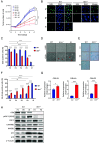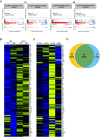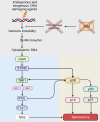The cGAS-STING, p38 MAPK, and p53 pathways link genome instability to accelerated cellular senescence in ATM-deficient murine lung fibroblasts
- PMID: 39772747
- PMCID: PMC11745328
- DOI: 10.1073/pnas.2419196122
The cGAS-STING, p38 MAPK, and p53 pathways link genome instability to accelerated cellular senescence in ATM-deficient murine lung fibroblasts
Abstract
Ataxia-telangiectasia (A-T) is a pleiotropic genome instability syndrome resulting from the loss of the homeostatic protein kinase ATM. The complex phenotype of A-T includes progressive cerebellar degeneration, immunodeficiency, gonadal atrophy, interstitial lung disease, cancer predisposition, endocrine abnormalities, chromosomal instability, radiosensitivity, and segmental premature aging. Cultured skin fibroblasts from A-T patients exhibit premature senescence, highlighting the association between genome instability, cellular senescence, and aging. We found that lung fibroblasts derived from ATM-deficient mice provide a versatile experimental system to explore the mechanisms driving the premature senescence of primary fibroblasts lacking ATM. Atm-/- fibroblasts failed to proliferate under ambient oxygen conditions (21%). Although they initially proliferated under physiological oxygen levels (3%), they rapidly entered senescence. In contrast, wild-type (WT) lung fibroblasts did not senesce under 3% oxygen and eventually underwent immortalization and neoplastic transformation. However, rapid senescence could be induced in WT cells either by Atm gene ablation or persistent chemical inhibition of ATM kinase activity, with senescence induced by ATM inhibition being reversible upon inhibitor removal. Moreover, the concomitant loss of ATM and p53 led to senescence evasion, vigorous growth, rampant genome instability, and subsequent immortalization and transformation. Our findings reveal that the rapid senescence of Atm-/- lung fibroblasts is driven by the collaborative action of the cGAS-STING, p38 MAPK, and p53 pathways in response to persistent DNA damage, ultimately leading to the induction of interferon-α1 and downstream interferon-stimulated genes. We propose that accelerated cellular senescence may exacerbate specific A-T symptoms, particularly contributing to the progressive, life-threatening interstitial lung disease often observed in A-T patients during adulthood.
Keywords: ATM; ataxia–telangiectasia; cGAS-STING; p53; senescence.
Conflict of interest statement
Competing interests statement:The authors declare no competing interest.
Figures





Similar articles
-
Accelerated replicative senescence of ataxia-telangiectasia skin fibroblasts is retained at physiologic oxygen levels, with unique and common transcriptional patterns.Aging Cell. 2023 Aug;22(8):e13869. doi: 10.1111/acel.13869. Epub 2023 May 30. Aging Cell. 2023. PMID: 37254625 Free PMC article.
-
Selenoprotein H suppresses cellular senescence through genome maintenance and redox regulation.J Biol Chem. 2014 Dec 5;289(49):34378-88. doi: 10.1074/jbc.M114.611970. Epub 2014 Oct 21. J Biol Chem. 2014. PMID: 25336634 Free PMC article.
-
Stress-induced premature senescence in hTERT-expressing ataxia telangiectasia fibroblasts.J Biol Chem. 2004 Jan 16;279(3):2030-7. doi: 10.1074/jbc.M309457200. Epub 2003 Oct 21. J Biol Chem. 2004. PMID: 14570874
-
The cerebellar degeneration in ataxia-telangiectasia: A case for genome instability.DNA Repair (Amst). 2020 Nov;95:102950. doi: 10.1016/j.dnarep.2020.102950. Epub 2020 Aug 23. DNA Repair (Amst). 2020. PMID: 32871349 Review.
-
The hallmarks of aging in Ataxia-Telangiectasia.Ageing Res Rev. 2022 Aug;79:101653. doi: 10.1016/j.arr.2022.101653. Epub 2022 May 26. Ageing Res Rev. 2022. PMID: 35644374 Review.
Cited by
-
The cold immunological landscape of ATM-deficient cancers.J Immunother Cancer. 2025 May 11;13(5):e010548. doi: 10.1136/jitc-2024-010548. J Immunother Cancer. 2025. PMID: 40350205 Free PMC article.
-
ZC3H4 safeguards genome integrity by preventing transcription-replication conflicts at noncoding RNA loci.Sci Adv. 2025 Jun 20;11(25):eadt8346. doi: 10.1126/sciadv.adt8346. Epub 2025 Jun 18. Sci Adv. 2025. PMID: 40531993 Free PMC article.
-
Profile of Yosef Shiloh.Proc Natl Acad Sci U S A. 2025 Jan 21;122(3):e2426242122. doi: 10.1073/pnas.2426242122. Epub 2025 Jan 14. Proc Natl Acad Sci U S A. 2025. PMID: 39808656 Free PMC article. No abstract available.
-
The cGAS-STING pathway in atherosclerosis.Front Cardiovasc Med. 2025 Apr 25;12:1550930. doi: 10.3389/fcvm.2025.1550930. eCollection 2025. Front Cardiovasc Med. 2025. PMID: 40351606 Free PMC article. Review.
-
The STING Signaling: A Novel Target for Central Nervous System Diseases.Cell Mol Neurobiol. 2025 Apr 7;45(1):33. doi: 10.1007/s10571-025-01550-4. Cell Mol Neurobiol. 2025. PMID: 40195137 Free PMC article. Review.
References
-
- de Almeida L. C., Calil F. A., Machado-Neto J. A., Costa-Lotufo L. V., DNA damaging agents and DNA repair: From carcinogenesis to cancer therapy. Cancer Genet. 252–253, 6–24 (2021). - PubMed
MeSH terms
Substances
Grants and funding
LinkOut - more resources
Full Text Sources
Molecular Biology Databases
Research Materials
Miscellaneous

